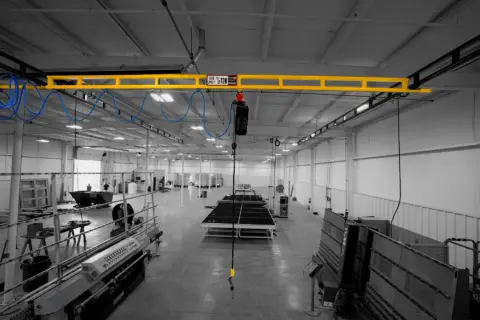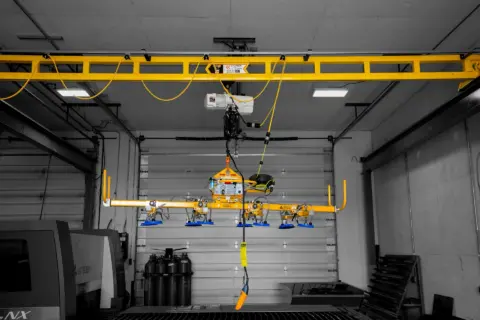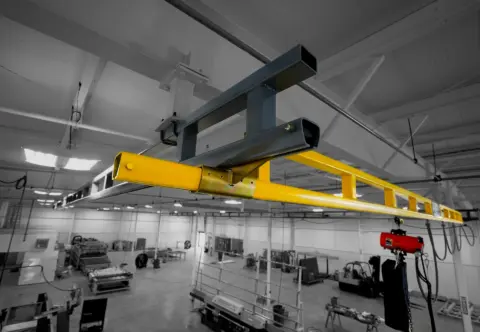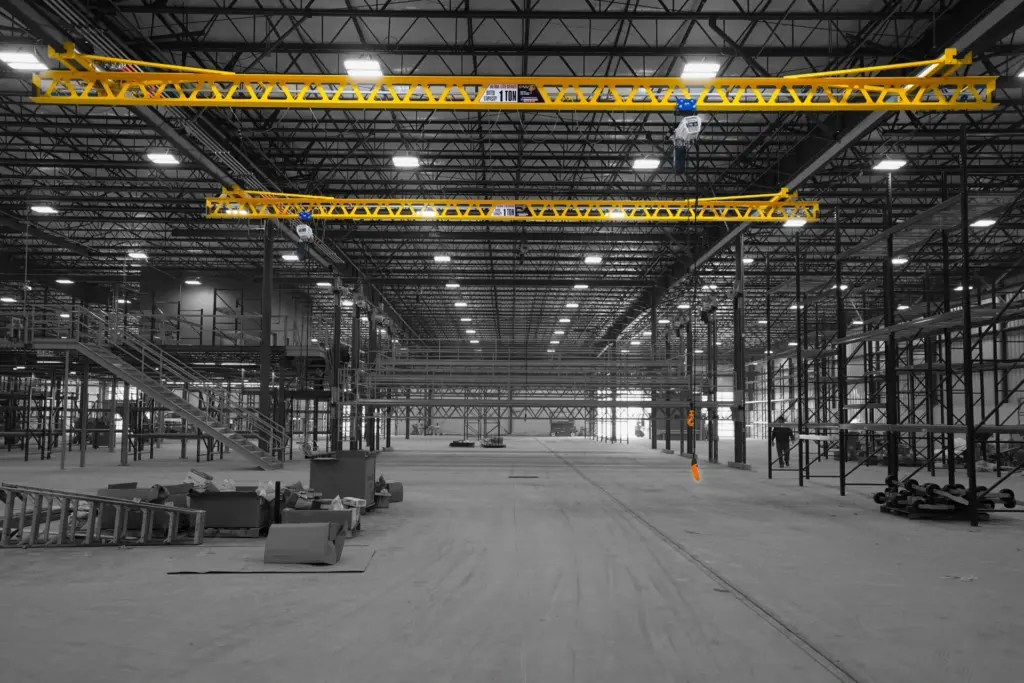Is your shop floor bottlenecked because forklifts can’t keep up—but you think cranes are too expensive or complicated? You might be overlooking your perfect solution.

So what exactly is a workstation crane?
Workstation cranes are lightweight, manually operated overhead lifting systems designed specifically for cell-based manufacturing or assembly line tasks. Think of them like those easy-glide curtain rods at home: effortless to move by hand, even when you’re carrying heavier items.
They’re commonly found in small work cells, production lines, or welding areas. For example, you might see someone lifting a metal sheet off a laser CNC table, effortlessly moving it to a cart beside them, and rolling it off to another station.
Here’s the basic rundown of a workstation crane:
- Lightweight and easy to move manually (no motorization required).
- Typically handle from lightweight up to around 6,000 pounds.
- Modular, easy to assemble structure that doesn’t require heavy equipment to install.
- Allows just about anyone in your shop (no matter their strength) to precisely position loads.

What makes a workstation crane different from other cranes?
Here’s a straightforward breakdown:
- Manual vs. motorized: Workstation cranes are almost always fully manual. Other, heavier-duty crane types are motorized for easier lifting of heavier loads.
- Portability: Beyond being stationary, workstation cranes can also be mounted on wheels or tracks for added flexibility.
- Precision and speed: Manual cranes offer precise control in small spaces. Motorized cranes may move faster over long distances but lack the same instant, hands-on precision.
- Capacity: Ideal for lighter loads (generally 6,000 pounds or less).
You might wonder: Do motorized cranes ever handle light loads? Sure, they can—but generally, they’re less efficient for tasks needing quick, hands-on precision compared to a lightweight manual crane, where operators can quickly and deliberately position items.

Different types of workstation cranes
Workstation cranes fall under three primary categories:
- Bridge cranes
- Freestanding: Like our HyperLite or UltraLite models—stand-alone, easily movable.
- Ceiling-mounted: Mounted directly to building structures, saving valuable floor space.
- Gantry cranes
- Mobile: On casters allowing complete movement and flexibility.
- Track-mounted: Primarily for motorized options that are designed to travel a linear path where maintaining alignment is critical.
- Jib cranes
- Wall-mounted: Mounted directly onto existing building walls or columns.
- Floor-mounted: Sturdy mounted directly to your shop floor.
- Articulating Jib: An arm crane that moves around pivot points, allowing you to maneuver around obstacles. Perfect for tight workspaces.

Features and add-ons you can expect
While workstation cranes themselves are typically straightforward, there are still plenty of customization options, depending on the specific product you choose:
- Motorized trolleys: Available for some workstation cranes (like our UltraLite series) allowing horizontal left/right powered movement.
- Radio control systems: Control lifting and rotation of your crane (or even gripping items with vacuum lifters) remotely.
- Vacuum lifters: Attach a vacuum-based grabbing device directly to your crane for safer, faster handling of sheet metal or similar materials. At PWI, we’re soon releasing our own line of vacuum lifters that fully integrate into your workstation crane setup for seamless productivity.

How fast and how heavy can workstation cranes go?
- Lift capacities typically range from zero to around 6,000 pounds.
- Lift speeds can be as quick as 50 feet per minute with a manually guided trolley system—faster than most realize.
- Travel speeds (for optional motorized trolleys): Up to a whopping 82 feet per minute. They’re fast when you need speed and accurate positioning.
So, what’s the cost range?
The cost of workstation cranes varies based on type and features:
- Bridge cranes: $10,000–$60,000. Price depends heavily on span length, runway length, add-ons, and capacities.
- Jib and gantry cranes: $5,000–$30,000. These simpler systems cost less but are more limited in their capabilities and coverage area.
The biggest price influencers are the size/length of crane, material, lifting capacity, and additional control options like variable speed or radio control systems. Opting for more premium, enclosed-track brands like HyperLite will increase the price slightly, due to greater labor in manufacturing.

Maintenance cost and care
Workstation cranes require little day-to-day maintenance, but annual inspections keep them safe and operational. You’ll mainly want to keep an eye on standard wear items like bearings, casters, hooks, and lifting chains to stay trouble-free. Good maintenance extends the crane’s life—and ensures safer operation on your shop floor.
Alternatives to workstation cranes?
Sometimes a workstation crane isn’t the right choice. Alternatives can include:
- Forklift trucks: Best for quick, mobile material handling. Sometimes a forklift is simply more efficient, especially for loading/unloading tasks. (We’ve even recommended forklifts instead of cranes when it made sense for our customers).
- Pallet jacks: Ideal for lighter items or smoother floors—also great for mezzanines.
- Manually picking things up (not ideal): Bad for your team’s backs, safety, and morale, but still unfortunately common.
How to determine if a workstation crane is your best bet
When customers approach me at PWI, we always examine a few key considerations:
- Application type: Are you moving a load from A to B repeatedly (like a jib) or moving it frequently around different points in a workspace (like a bridge crane)?
- Capacity needs: Workstation cranes handle up to around 6,000 pounds, ideal for most light-medium operations. Anything beyond that, motorized cranes typically make more sense.
- Frequency of lifts per hour: High-cycle environments (like automotive assembly lines) need higher-performance crane setups compared to intermittent fab-shop lifting.
Recently, we set up an impressive workstation crane system for Barletta Boats. Seeing an entire facility operating smoothly with multiple workstation cranes overhead reinforced how this simple addition can transform productivity and workflow safety.

What are the main pros and cons?
Pros:
- Cost-effective lifting solution for small-to-medium tasks
- Lightweight, portable, and modular—easily moved or reconfigured
- Precise manual control perfect for assembly lines and tight workspaces
Cons:
- Limited by their maximum load capacity (around 6,000 pounds)
- Manual-only means workers provide the movement energy themselves—this sometimes isn’t ideal with certain applications or higher loads.
In closing
Thinking a workstation crane might fit your shop? Don’t just guess about lifting loads—let’s eliminate that stress from your mind. We offer free quotes and drawings with no pressure—often advising customers on cheaper options (like forklifts!) when they make sense.


